Lesson Contents
OSPF uses eight different LSA types (Link State Advertisements) to build its LSDB (Link State Database) and share routing information between routers. Each LSA type has a specific purpose and flooding scope where it is flooded only within or between areas. In this lesson, we’ll take a look at the different LSA types and I’ll show you how to identify them on Cisco IOS routers.
LSA Types Overview
Let’s start with an overview of all LSA types:
| LSA Type 1: | Router LSA |
| LSA Type 2: | Network LSA |
| LSA Type 3: | Summary LSA |
| LSA Type 4: | Summary ASBR LSA |
| LSA Type 5: | Autonomous system external LSA |
| LSA Type 6: | Multicast OSPF LSA |
| LSA Type 7: | Not-so-stubby area LSA |
| LSA Type 8: | External attribute LSA for BGP |
For many students, visualizing helps them understand and remember. I like to visualize OSPF LSAs as jigsaw puzzle pieces. One jigsaw means nothing, but all of them together give us the total picture…for OSPF, this is the LSDB.
LSA Type 1
Here’s the first LSA Type:
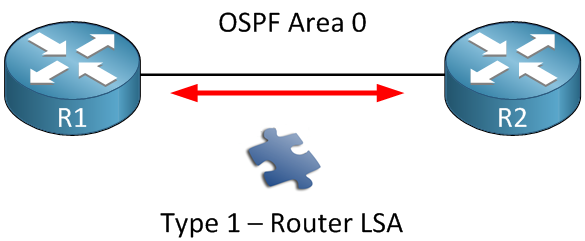
Each router within the area will flood a type 1 router LSA within the area. In this LSA you will find a list with all the directly connected links of this router. How do we identify a link?
- The IP prefix on an interface.
- The link type. There are 4 different link types:
| Link Type | Description | Link ID |
| 1 | Point-to-point connection to another router. | Neighbor router ID |
| 2 | Connection to transit network. | IP address of DR |
| 3 | Connection to stub network. | IP Network |
| 4 | Virtual Link | Neighbor router ID |
Don’t worry too much about the link types for now, we will see them later. Keep in mind that the router LSA always stays within the area.
LSA Type 2
The second LSA type (network LSA) is created for multi-access networks:
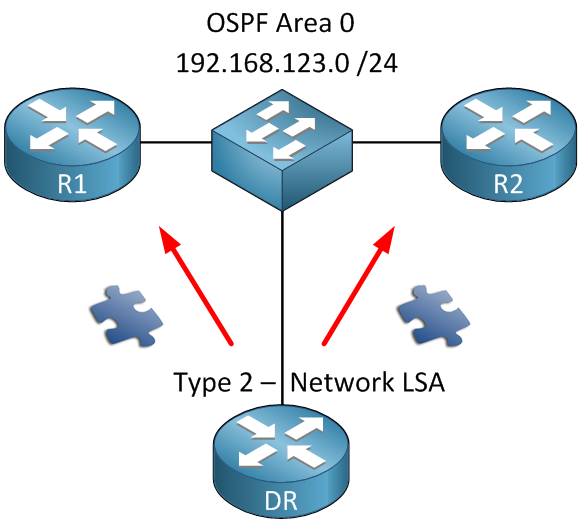
The network LSA or type 2 is created for each multi-access network. Remember the OSPF network types? The broadcast and non-broadcast network types require a DR/BDR. If this is the case you will see these network LSAs being generated by the DR. In this LSA we will find all the routers that are connected to the multi-access network, the DR and of course the prefix and subnet mask.
In my example above we will find R1, R2 and the DR in the network LSA. We will also see the prefix 192.168.123.0 /24 in this LSA. Last thing to mention: the network LSA always stays within the area.
LSA Type 3
Let’s look at the third LSA type:
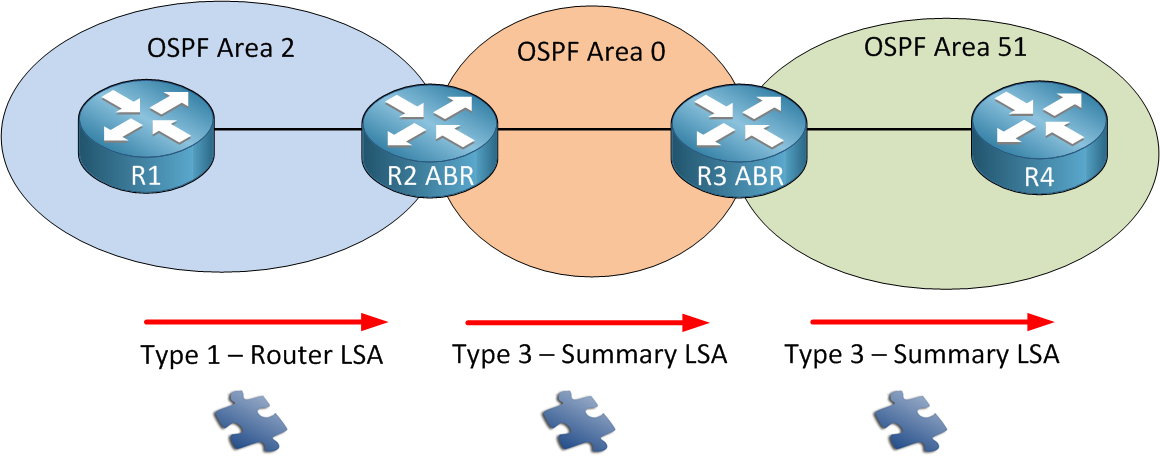
Type 1 router LSAs always stay within the area. OSPF however works with multiple areas and you probably want full connectivity within all of the areas. R1 is flooding a router LSA within the area so R2 will store this in its LSDB. R3 and R4 also need to know about the networks in Area 2.
R2 is going to create a Type 3 summary LSA and flood it into area 0. This LSA will flood into all the other areas of our OSPF network. This way all the routers in other areas will know about the prefixes from other areas.
The name “summary” LSA is very misleading. By default OSPF is not going to summarize anything for you. There is however a command that let you summarize inter-area routes. Take a look at my OSPF summarization lessonif you are interested. If you are looking at the routing table of an OSPF router and see some O IA entries you are looking at LSA type 3 summary LSAs. Those are your inter-area prefixes!
LSA Type 4
Time for the fourth LSA type:
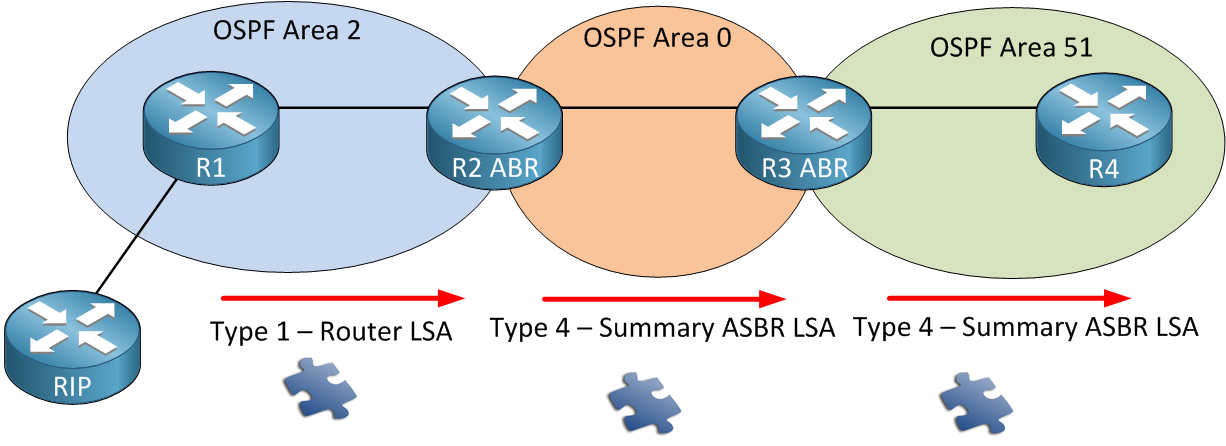 In this example we have R1 that is redistributing information from the RIP router into OSPF. This makes R1 an ASBR (Autonomous System Border Router). What happens is that R1 will flip a bit in the router LSA to identify itself as an ASBR. When R2 who is an ABR receives this router LSA it will create a type 4 summary ASBR LSA and flood it into area 0. This LSA will also be flooded in all other areas and is required so all OSPF routers know where to find the ASBR.
In this example we have R1 that is redistributing information from the RIP router into OSPF. This makes R1 an ASBR (Autonomous System Border Router). What happens is that R1 will flip a bit in the router LSA to identify itself as an ASBR. When R2 who is an ABR receives this router LSA it will create a type 4 summary ASBR LSA and flood it into area 0. This LSA will also be flooded in all other areas and is required so all OSPF routers know where to find the ASBR.
LSA Type 5
What about LSA type 5? Let’s check it out:

Same topology but I’ve added a prefix (5.5.5.0 /24) at our RIP router. This prefix will be redistributed into OSPF. R1 (our ASBR) will take care of this and create a type 5 external LSA for this. Don’t forget we still need type 4 summary ASBR LSA to locate R1. If you ever tried redistribution with OSPF you might have seen O E1 or E2 entries. Those are the external prefixes and our type 5 LSAs.
LSA Type 6
What about OSPF LSA type 6? Type 6 multicast ospf LSA I can skip because it’s not being used. Cisco does not even support it. We use PIM (Protocol Independent Multicast) for multicast configurations.
LSA Type 7
Let’s look at the last LSA type, number 7:
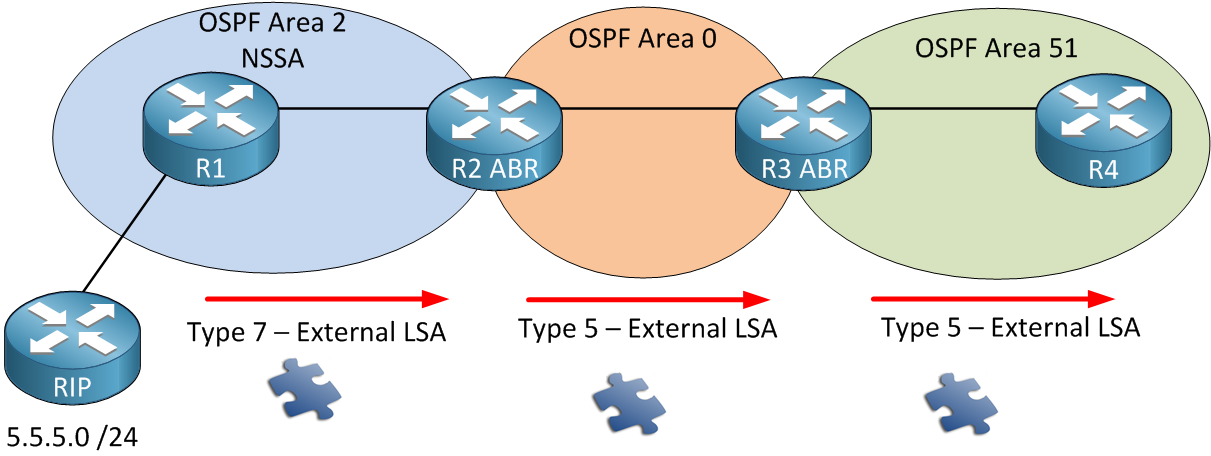
NSSA areas do not allow type 5 external LSAs. In my picture R1 is still our ASBR redistributing information from RIP into OSPF.
Since type 5 is not allowed we have to think of something else. That’s why we have a type 7 external LSA that carries the exact same information but is not blocked within the NSSA area. R2 will translate this type 7 into a type 5 and flood it into the other areas.
Summary
Let me summarize the LSA types for you:
- Type 1 – Router LSA: The Router LSA is generated by each router for each area it is located. In the link-state ID you will find the originating router’s ID.
- Type 2 – Network LSA: Network LSAs are generated by the DR. The link-state ID will be the interface IP address of the DR.
- Type 3 – Summary LSA: The summary LSA is created by the ABR and flooded into other areas.
- Type 4 – Summary ASBR LSA: Other routers need to know where to find the ASBR. This is why the ABR will generate a summary ASBR LSA which will include the router ID of the ASBR in the link-state ID field.
- Type 5 – External LSA: also known as autonomous system external LSA: The external LSAs are generated by the ASBR.
- Type 6 – Multicast LSA: Not supported and not used.
- Type 7 – External LSA: also known as not-so-stubby-area (NSSA) LSA: As you can see area 2 is a NSSA (not-so-stubby-area) which doesn’t allow external LSAs (type 5). To overcome this issue we are generating type 7 LSAs instead.
Configuration
We can see all the OSPF types in the LSDB. To demonstrate this, I will use the following topology:

It’s a simple setup with three routers and two areas. I’ve added a couple of loopbacks so we have prefixes to look at. Here’s the configuration:
R1(config)#router ospf 1
R1(config-router)#network 192.168.12.0 0.0.0.255 area 0
R1(config-router)#network 1.1.1.0 0.0.0.255 area 0R2(config)#router ospf 1
R2(config-router)#network 192.168.12.0 0.0.0.255 area 0
R2(config-router)#network 192.168.23.0 0.0.0.255 area 1R3(config)#router ospf 1
R3(config-router)#network 192.168.23.0 0.0.0.255 area 1
R3(config-router)#network 3.3.3.0 0.0.0.255 area 1Let’s start by looking at the LSDB of R1:
R1#show ip ospf database
OSPF Router with ID (1.1.1.1) (Process ID 1)
Router Link States (Area 0)
Link ID ADV Router Age Seq# Checksum Link count
1.1.1.1 1.1.1.1 30 0x80000003 0x004CD9 2
2.2.2.2 2.2.2.2 31 0x80000002 0x0048E9 1
Net Link States (Area 0)
Link ID ADV Router Age Seq# Checksum
192.168.12.2 2.2.2.2 31 0x80000001 0x008F1F
Summary Net Link States (Area 0)
Link ID ADV Router Age Seq# Checksum
3.3.3.3 2.2.2.2 17 0x80000001 0x00D650
192.168.23.0 2.2.2.2 66 0x80000001 0x00A70CBy using the show ip ospf database we can look at the LSDB and we can see the type 1 router LSAs, type 2 network LSAs and the type 3 summary LSAs here. What else do we find here?
- Link ID: This is what identifies each LSA.
- ADV router: the router that is advertising this LSA.
- Age: The maximum age counter in seconds. The maximum is 3600 seconds or 1 hour.
- Seq#: Here you see the sequence number which starts at 0x80000001 and will increase by 1 for each update.
- Checksum: There is a checksum for each LSA.
- Link count: This will show the total number of directly connected links and is only used for the router LSA.
So that’s LSA type 1,2 and 3. To show you number 4 and 5 I have to make some changes:
 To accomplish this I will redistribute something on R1 into OSPF.
To accomplish this I will redistribute something on R1 into OSPF.
R1(config)#interface loopback 1
R1(config-if)#ip address 11.11.11.11 255.255.255.0
R1(config-if)#exit
R1(config)#router ospf 1
R1(config-router)#redistribute connected subnetsI created an additional loopback interface and configured an IP address. Then I’m telling OSPF to redistribute the directly connected interfaces into OSPF. Let’s look at the LSDB of R2 and R3:
R2#show ip ospf database | begin Type-5
Type-5 AS External Link States
Link ID ADV Router Age Seq# Checksum Tag
11.11.11.0 1.1.1.1 36 0x80000001 0x000F44 0Here you can see the type 5 external LSA in the LSDB of R2. Let’s look at R3:
R3#show ip ospf database | begin Summary
Summary Net Link States (Area 1)
Link ID ADV Router Age Seq# Checksum
1.1.1.1 2.2.2.2 149 0x80000001 0x0033FB
192.168.12.0 2.2.2.2 195 0x80000001 0x00219D
Summary ASB Link States (Area 1)
Link ID ADV Router Age Seq# Checksum
1.1.1.1 2.2.2.2 62 0x80000001 0x004DB9
Type-5 AS External Link States
Link ID ADV Router Age Seq# Checksum Tag
11.11.11.0 1.1.1.1 68 0x80000001 0x000F44 0R3 is in another area than R1 so it needs to know where to find the ASBR. In the LSDB you can see the type 5 external LSA but also the type 4 summary ASBR LSA which is the address of R1. Because of this LSA, R3 knows how to reach the ASBR. This type 4 LSA is being generated by R2 which is the ABR.
There’s only one more LSA type to show you and that’s number 7. I’ll have to use the NSSA area type for this:


Great job,your example are very smooth to learn .
very concise exlanation!
I have to tell you that I have seen different videos and took CCNP Training and never understood completely the Area Types but you explain it so easy that I understand now.
Thanks
In the above topology, when I redistribute connected on R2 and R3, R1 sees only one LSA type 4. It’s for R2 showing how to get to R3. Why don’t we also see an LSA type 4 for R2’s redistributed routes? Does a directly connected router not generate an LSA type 4 for its redistributed routes? Whew!
Hi,
In your explanation about LSA type 5, you wrote :
“Here you can see the type 5 external LSA in the LSDB. Keep in mind that router R2 and R3 both are in area 0.”
But, in the design, we can see that there are in area 1 ?
Regards.